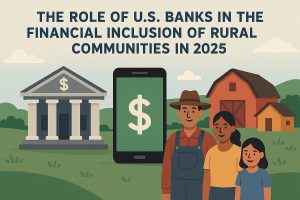The financial industry is undergoing a massive shift as sustainability moves from a corporate buzzword to a critical business strategy. US banks are no longer passive players in the climate conversation; they are actively investing in initiatives that support environmental responsibility, sustainable finance, and greener business practices.
From funding renewable energy projects to embedding eco-conscious policies into their operations, major financial institutions are recognizing that their role in the economy extends beyond profitability. Banks now face growing pressure from regulators, investors, and consumers to demonstrate a meaningful commitment to sustainability, and the competition to lead the green banking revolution is heating up.
Financing the future: investments in green projects

One of the most direct ways banks are advancing sustainability is by financing projects that promote clean energy and environmental protection. Many major financial institutions have committed billions of dollars to fund renewable energy initiatives, carbon reduction efforts, and sustainable infrastructure.
JPMorgan Chase, for example, has pledged $2.5 trillion toward sustainability-linked investments over the next decade, including clean energy financing and community development programs focused on environmental resilience. Similarly, Bank of America has set an ambitious target of mobilizing $1.5 trillion in sustainable finance by 2030, aiming to support businesses and communities in transitioning to a low-carbon economy.
These investments are not just about reputation management—they make financial sense. As the world moves away from fossil fuels, industries reliant on traditional energy sources face growing risks, while the renewable energy sector presents lucrative opportunities.
Banks are positioning themselves at the forefront of this transition, supporting wind and solar energy projects, electric vehicle infrastructure, and green building developments. Goldman Sachs, for instance, has been a leading financier of clean energy initiatives, channeling significant capital into solar farms, wind power projects, and emerging green technologies.
Beyond large-scale corporate financing, banks are also offering sustainable lending options to businesses and consumers. Green loans and sustainability-linked credit lines reward companies that meet specific environmental goals, encouraging them to adopt eco-friendly practices.
At the consumer level, banks are introducing green mortgage products, which offer better interest rates for homebuyers purchasing energy-efficient properties. These initiatives signal a fundamental shift in the financial industry—one where capital is increasingly directed toward businesses and projects that contribute to a sustainable future.
Redefining banking operations: sustainability from within
While financing green projects is a significant step, banks are also looking inward, transforming their own operations to align with sustainability goals. Many US financial institutions are committing to carbon neutrality, reducing their direct environmental impact by making their branches, data centers, and corporate offices more energy-efficient.
Citigroup, for example, has pledged to achieve net-zero emissions in its operations by 2030 and is investing in renewable energy sources to power its facilities. Similarly, Wells Fargo has committed to operating on 100% renewable energy, while also reducing waste and improving energy efficiency across its offices.
Digital transformation has also played a crucial role in reducing banks’ carbon footprints. With the rise of online and mobile banking, institutions are increasingly moving away from paper-based processes, cutting down on waste and minimizing resource consumption.
Chase, for instance, has implemented digital banking solutions that not only improve customer convenience but also reduce reliance on physical branches and printed statements. By encouraging digital adoption, banks can significantly lower their environmental impact while improving operational efficiency.
Sustainable procurement is another area where banks are making changes. Many institutions are revising their supply chain policies to prioritize vendors with strong environmental and social responsibility standards. This shift extends to everything from office supplies to corporate travel policies, as banks seek to embed sustainability into every aspect of their business.
The power of influence: shaping a greener economy
Banks have an immense influence on the broader economy, and their sustainability initiatives extend beyond their own balance sheets. By integrating Environmental, Social, and Governance (ESG) criteria into their investment and lending decisions, financial institutions are encouraging businesses across industries to adopt more sustainable practices.
One of the most significant developments in this space is the rise of sustainability-linked bonds and green bonds. These financial instruments are designed to fund projects with clear environmental benefits, such as renewable energy, clean transportation, and climate adaptation initiatives.
Banks are not only issuing these bonds but also advising corporate clients on how to structure them, making sustainability a key component of modern finance. Morgan Stanley, for example, has been a leader in sustainable investment banking, guiding companies through the process of securing green financing for large-scale environmental projects.
Consumer demand is also driving change, as individuals increasingly seek out financial products that align with their values. Many banks now offer sustainable investment options, such as ESG-focused mutual funds and green savings accounts, which allow customers to invest in environmentally responsible projects.
Regulation is another factor pushing banks toward sustainability. Policymakers and financial watchdogs are tightening regulations around climate risk disclosure and responsible investing, forcing banks to be more transparent about their environmental impact.
The US Securities and Exchange Commission (SEC) is working on new requirements that would mandate public companies, including banks, to disclose their climate-related risks and sustainability efforts. This regulatory pressure is reinforcing the idea that sustainability is not optional—it is an essential part of long-term financial stability.
The future of green banking
The push for sustainability in the US banking sector is not a passing trend; it is a fundamental transformation that is reshaping the way financial institutions operate. Banks are realizing that sustainable finance is not just about doing the right thing—it is a strategic imperative that influences risk management, profitability, and customer engagement.
As regulatory requirements tighten, technology advances, and public awareness grows, banks that lead in sustainability will be better positioned to thrive in the evolving financial landscape. Looking ahead, we can expect to see even more innovative approaches to sustainable banking.
Advances in artificial intelligence and blockchain technology could enhance the transparency and effectiveness of green finance, while new financial products could make it easier for individuals and businesses to invest in sustainability. Banks will need to continue adapting, embracing bold initiatives that drive positive environmental change while maintaining financial stability.
Sustainability is no longer a side initiative—it is becoming a core principle of modern banking. The question is not whether banks will invest in sustainability, but how quickly they can accelerate their efforts to build a greener, more resilient financial system.






